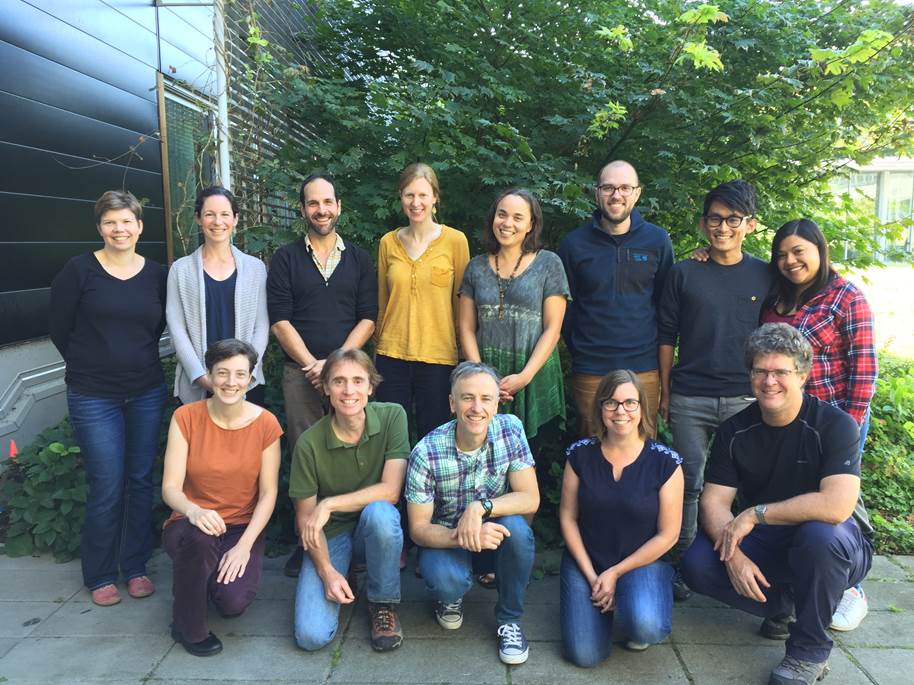Research: eco-evolutionary feedbacks in dispersal
What ecological factors drive the evolution of dispersal, and how does dispersal behavior feed back to influence these ecological factors?
|
Individual dispersal is driven in part by the spatial distribution of resources and of other individuals. Yet as individuals disperse, they alter these distributions, and therefore the selective pressures on their own dispersal (an eco-evolutionary feedback loop). We show that the relative timing of dispersal and mating influences the evolution of sex differences in dispersal (Shaw & Kokko 2014), and that both mating timing and sex differences influence a population's spread rate (Shaw & Kokko 2015). We find that allowing dispersal to adapt as a population spreads alters individual dispersal strategies, which in turn can either speed up or slow down the rate of population spread. Intriguingly, even though individuals face a mate-finding Allee effect (difficulty finding mates at the low density edge of the population), they often evolve movement rules that make it even harder to find mates (Shaw & Kokko 2015). This indicates that mating failures are not always associated with slower invasions. We are also exploring how eco-evolutionary feedbacks in dispersal play out in the context of spreading populations. As part of a 2018 CIEE working group, we synthesized our current understanding of the field (Miller et al. 2020). As part of a Fields working group, we aim to develop novel mathematical frameworks to address open questions. |
2018 CIEE Working Group: "Data and theory synthesis to resolve the effects of evolution on the predictability of range expansion"
|
Next steps
- What new mathematical theory is needed to understand the eco-evolutionary dynamics of population spread? (ongoing Fields Institute Working Group)
Relevant papers
Shaw AK, Lutscher F, Popovic L (2023) "Pushed to the edge: spatial sorting can slow down invasions." Ecology Letters 26(8): 1293-1300
Lutscher F, Popovic L, Shaw AK (2022) "How mutation shapes the rate of population spread in the presence of a mate-finding Allee effect." Theoretical Ecology
Weiss-Lehman C, Shaw AK (2022) "Understanding the drivers of dispersal evolution in range expansions and their ecological consequences." Evolutionary Ecology 36:181-197.
Miller TEX, Angert AL, Brown CD, Lee-Yaw JA, Lewis M, Lutscher F, Marculis NG, Melbourne BA, Shaw AK, Szűcs M, Tabares O, Usui T, Weiss-Lehman C, Williams JL (2020) "Eco-evolutionary dynamics of range expansion." Ecology 101(10): e03139.
Weiss-Lehman C, Shaw AK (2020) "Spatial population structure drives extinction dynamics in climate-induced range shifts." The American Naturalist 195(1): 31-42.
Shaw AK, Kokko H (2015) "Dispersal evolution in the presence of Allee effects can speed up or slow down invasions." American Naturalist 185(5): 631-639.
Shaw AK, Kokko H (2014) “Mate finding, Allee effects, and selection for sex-biased dispersal.” Journal of Animal Ecology 83(6): 1256–1267.
Lutscher F, Popovic L, Shaw AK (2022) "How mutation shapes the rate of population spread in the presence of a mate-finding Allee effect." Theoretical Ecology
Weiss-Lehman C, Shaw AK (2022) "Understanding the drivers of dispersal evolution in range expansions and their ecological consequences." Evolutionary Ecology 36:181-197.
Miller TEX, Angert AL, Brown CD, Lee-Yaw JA, Lewis M, Lutscher F, Marculis NG, Melbourne BA, Shaw AK, Szűcs M, Tabares O, Usui T, Weiss-Lehman C, Williams JL (2020) "Eco-evolutionary dynamics of range expansion." Ecology 101(10): e03139.
Weiss-Lehman C, Shaw AK (2020) "Spatial population structure drives extinction dynamics in climate-induced range shifts." The American Naturalist 195(1): 31-42.
Shaw AK, Kokko H (2015) "Dispersal evolution in the presence of Allee effects can speed up or slow down invasions." American Naturalist 185(5): 631-639.
Shaw AK, Kokko H (2014) “Mate finding, Allee effects, and selection for sex-biased dispersal.” Journal of Animal Ecology 83(6): 1256–1267.

